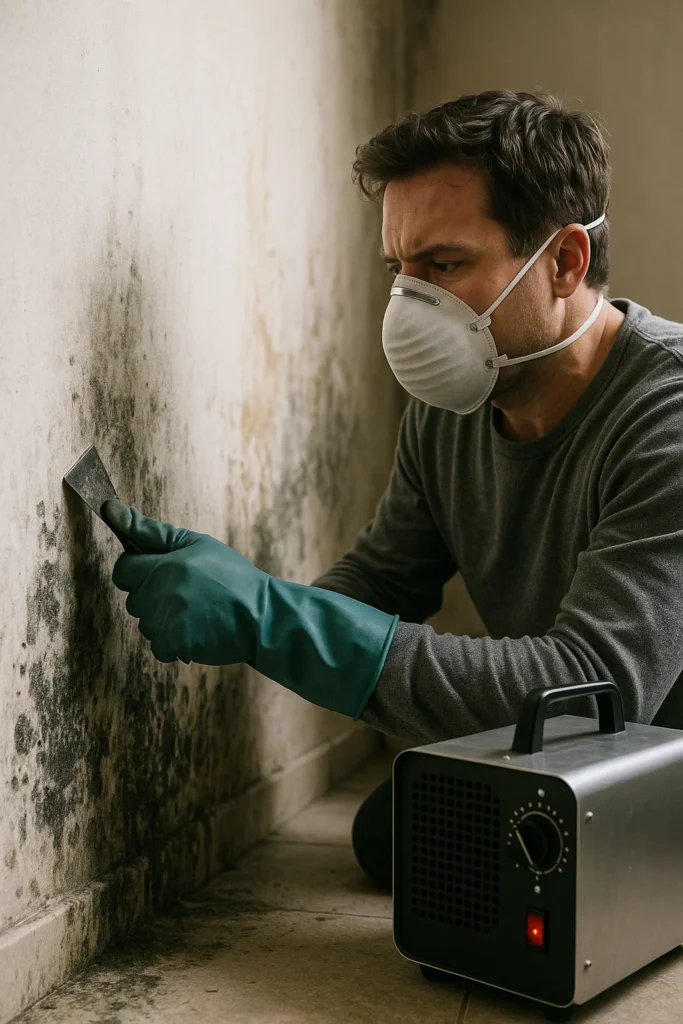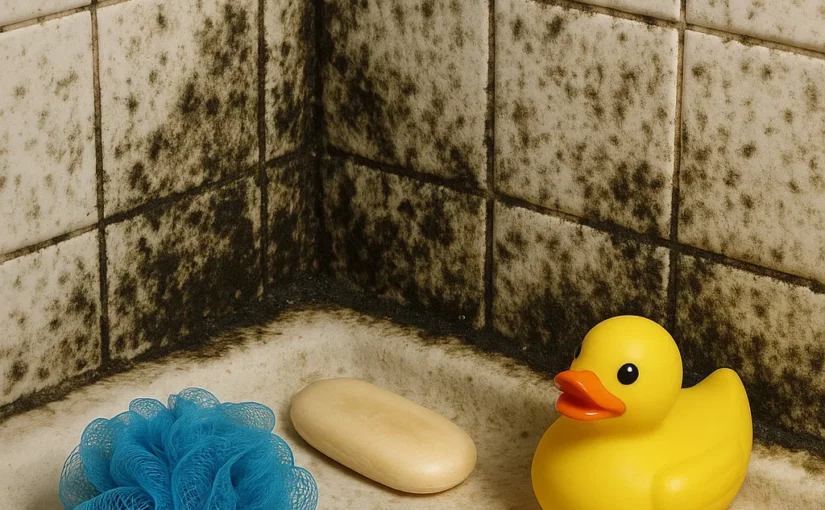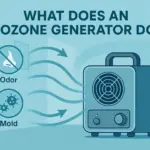Yes, ozone generators can remove mold smell from a house, but they must be used carefully and in unoccupied spaces. Ozone neutralizes the odor at a molecular level, breaking down the compounds that cause musty mold smells. However, it does not physically remove mold — just the smell — so it’s best used after mold remediation or for treating lingering odors.
Table of Contents
Why Mold Smell Is So Hard to Get Rid Of
Mold smell — often described as musty, damp, or earthy — tends to cling to porous materials like drywall, carpet, furniture, and HVAC ductwork. That’s because the odor is caused by microbial volatile organic compounds (VOCs) released by active or previously active mold colonies.
Even after you’ve scrubbed away visible mold, the smell can remain embedded in the structure of your home.
That’s why people often struggle with persistent odors even after cleaning or using air fresheners.
How Ozone Neutralizes Mold Odors at the Source
Ozone (O3) is a highly reactive gas made of three oxygen atoms. When released into the air, it breaks apart and reacts with odor-causing molecules, oxidizing and neutralizing them.
In the case of mold odors, ozone targets the MVOCs responsible for the musty smell. Unlike candles or sprays that only mask odors, ozone alters them chemically.
Keep in mind: Ozone is not a mold killer in and of itself. It may help slow surface-level spores, but it won’t replace proper mold remediation — it simply deals with the smell.
Read more about how ozone works here: What is an Ozone Machine?
 Step-by-Step: How to Use Ozone to Eliminate Mold Smell
Step-by-Step: How to Use Ozone to Eliminate Mold Smell
If you’re considering using an ozone generator to tackle a moldy smell, follow this careful process:
- Confirm mold removal has already taken place. Ozone is not a substitute for cleaning. If there’s still active mold growth, address it first.
- Choose the right-sized ozone generator. Use this guide: Ozone Generator Sizing Guide
- Prepare the space:
- Remove pets, people, and houseplants
- Seal the room by closing doors and windows
- Place the ozone machine in a central, elevated location
- Set the timer and exit the house:
- Run for 1–6 hours depending on room size and severity
- NEVER stay in the house while the generator is running
- Ventilate afterward: Wait 1–2 hours after the ozone cycle ends, then open windows and use fans to clear out remaining ozone.
More safety and timing tips: How Long to Wait After Using an Ozone Generator
A Quick Story: What Happened in Jill’s Basement
After a leak from her water heater soaked the basement carpet, Jill thought everything was fine once it dried out. But the smell stuck around. She tried candles, enzyme sprays, even baking soda — no luck.
Finally, she borrowed a friend’s ozone generator and treated the space for three hours. When she returned, the musty odor was completely gone. Two months later, still no sign of it returning. She was careful to air the basement out afterward and has since installed a dehumidifier to prevent future problems.
Ozone vs. Other Mold Odor Remedies
There are other methods people try when dealing with mold smells — here’s how ozone compares:
| Method | Effectiveness | Pros | Cons |
|---|---|---|---|
| Ozone Generator | High (odor removal) | Breaks down odor molecules; works throughout entire room | Can’t be used around people; doesn’t remove mold itself |
| Vinegar Spray | Moderate | Cheap, easy, safe | Smells bad; doesn’t penetrate deeply |
| Activated Charcoal | Low–Moderate | Absorbs odors passively | Slow-acting, limited range |
| UV HVAC Light | Preventative | Kills mold spores in ducts | Doesn’t eliminate current odors |
Explore UV options here: Pros and Cons of UV Light in HVAC
What About the Smell in Clothes, Curtains, and Upholstery?
Mold odor doesn’t just stick to walls — it can cling to **clothes, fabric furniture, and curtains**, too. Even after cleaning the room, these soft surfaces can reintroduce the smell.
Ozone can help deodorize these items as well — but with care.
If you place affected clothing or cushions in a sealed container or small room with an ozone machine, the odor can be neutralized just like it is in the air. A few tips:
- Place items in a closet, tote, or bathroom for targeted ozone treatment
- Make sure fabric is dry — ozone and moisture don’t mix well
- Let items air out completely before wearing or using again
If the smell persists even after ozone treatment, consider washing with baking soda and white vinegar, then drying thoroughly in the sun. Sunlight offers natural antimicrobial benefits and can help air out lingering odor.
Is DIY Ozone Treatment Enough — or Should You Hire a Pro?
For many homeowners, a small to medium-sized ozone machine is enough to tackle mold smells on their own. But if you’re dealing with a large home or strong odors after a flood, fire, or widespread mold infestation, professional remediation may be safer and more thorough.
Check out this related guide: Ozoning a House: Do’s and Don’ts
When Ozone Isn’t the Best Option
If the mold smell is coming from an HVAC system or constantly returning, ozone may only provide temporary relief. In that case, addressing moisture sources, cleaning ductwork, and adding a UV HVAC system or HEPA filtration unit may be more effective.
Alternatives worth exploring:
- HEPA air purifiers for continuous odor and spore filtration
- UV HVAC systems to kill airborne mold in ductwork
- Dehumidifiers to prevent future mold growth
- Enzyme-based cleaners for porous surfaces
Long-Term Fix: Keep Mold Smells from Returning
Using ozone may eliminate the musty odor for now — but **if the conditions that caused mold still exist, the smell will likely return.** Think of ozone as the final touch after the real work is done.
Here’s how to keep mold odors from creeping back:
- Run a dehumidifier — especially in basements, crawlspaces, or bathrooms
- Fix leaks and water damage immediately — even a small drip can trigger mold growth
- Use a humidity monitor (hygrometer) to stay under 50% RH indoors
- Ensure good airflow — open windows or use exhaust fans regularly
- Clean or replace HVAC filters and consider a UV light system to keep ducts clear of spores
Think of odor removal as part of a bigger plan: stop moisture, improve air circulation, and use tools like ozone or HEPA filtration when needed.
FAQ: Mold Smell and Ozone Generators
Will ozone kill mold?
No — ozone neutralizes odors but doesn’t physically kill or remove mold colonies. You need mold remediation for that.
How long does it take for ozone to remove mold smell?
Most treatments take 1–6 hours depending on the size and severity of the space. Smells often fade completely within 24 hours.
Is it safe to use an ozone generator in a house?
Yes — as long as the space is unoccupied during treatment and properly ventilated afterward. Ozone can irritate lungs, so follow all safety guidelines.
How can I prevent mold smells from coming back?
Control moisture with a dehumidifier, fix leaks, improve ventilation, and consider a UV light system for your HVAC to stop airborne mold spores.





